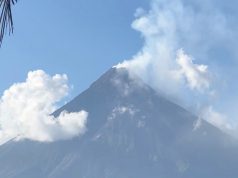The water table of deep wells in the vicinity of the crater of Mt. Mayon, the volcano currently in hyperactive state, are starting to recede in the face of more frequently occurring eruption events.
The events are marked by the restive oozing and fountaining of lava, furious expulsion of boulders as big as cars, and angry discharge of thick columns of ash and spatters of sediment as high as several hundred meters above the crater rim.
Volcanologists and geologists from the Philippine Institute of Volcanology and Seismology (Phivolcs) explained that the agitated state of the molten material, churning and making its way up from under the outer crust, is effectively shaking up or reconfiguring the underground geology, thus influencing the retention and circulation of water in the aquifers.

The grumblings of volcanic activity, resulting in spectacular sprays of lava and molten sediment, were observed to be coming in shorter frequency of about four hours each episode – far more frequent than in the days just past.
One of the recent eruptive events, at around 6:00 p.m. Thursday, was followed by yet another hissing, grumbling and grousing tantrum that sprayed lava and rocks and boulders outward from the mouth of the crater.
Oldtimers and villagers hailing from the flanks of the mountain were saying this was the first time Mayon Volcano behaved like this in recent memory, describing the eruption was “more violent” and “more spectacular”.
Drizzles of ash fall continue to shower down depending on where the wind takes them for many kilometers around and beyond Albay province, prompting authorities and disaster response teams, like the Philippine Red Cross, to distribute dust masks.

The serially growling and bellicose behavior was noted to have become the norm after Phivolcs declared Alert Level 4 just a few days ago, in a calibrated response to the observed volcanic activity. Level 4 is just one notch below the maximum alert level of 5, which denotes a violently explosive eruption in full progress.
According to Paul Alanis, a Phivolcs Research Specialist, because of the relatively small gaps in the crater through which most of the pyroclastic material was being extruded, pent-up pressure gets somewhat relieved for a while, and some of the narrow outlets tend to cool down, leading some of the molten material to solidify and form crust layers.
The crust layers, in turn, become temporary plugs that lead to further pressure build-up from underneath, until sufficient pressure accumulates to force molten material out against, somewhat like a hemorrhage of lava, so to speak.
And this has now been happening at intervals of more or less three to four hours.
About a thousand displaced persons are presently served at the evacuation center in Sto. Domingo, Albay.







